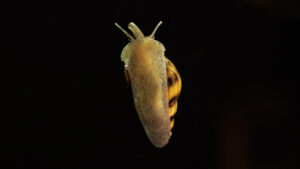If you are looking for great tank cleaners that can keep your tank’s algae in check, you can’t go wrong with nerite snails.
But what’s the safe stocking level? I’m sure you won’t like to deal with the fuss of ending up with too many nerite snail eggs in your tank.
Here’s How Many Nerite Snails You Can Keep Per Gallon:
Generally, you can keep one nerite snail per 5 gallons of water. Although you can slightly increase the number per gallon if you need faster and more effective algae control, they can lay a lot of eggs, so it is better to be conservative.
These snails are among the most popular aquarium snails known for their tank cleaning abilities. And when it comes to cleaning algae, nerite snails are pretty serious!
They clean off the algae from aquarium plants, decorations, and glass. They munch on hair algae, keep the substrate clean, and help you keep the tank pretty much spotless!
Also, when choosing nerite snails, you get various options considering their unique colors and patterns.
Here are some of the Nerite Snail type and their brief description.
| Nerite Snail Type: | Description: |
| Zebra Nerite Snail | Yellow or Black stripes across their shells. |
| Tiger Nerite Snail | Orange stripes and looks like Tiger’s Coat |
| Horned Nerite Snail | Black and Yellow stripes with Spiky Horns |
| Red Racer Nerite Snail | Bright Red or sometimes Yellow |
But any aquarist’s primary concern is not to get overwhelmed with too many snails or eggs in their tank. And that’s why it is good to start with the proper stocking levels of nerite snails from the get-go.
Here’s a chart that shows the general recommendation of nerite snails numbers based on the tank size:
| Nerite Snail Number: | Tank Capacity: |
| 1 | 5 Gallons |
| 2 | 10 Gallons |
| 3 | 15 Gallons |
| 4 | 20 Gallons |
| 5 | 25 Gallons |
| 6 | 30 Gallons |
| 7 | 35 Gallons |
| 8 | 40 Gallons |
| 9 | 45 Gallons |
| 10 | 50 Gallons |
| 11 | 55 Gallons |
| 12 | 60 Gallons |
| 13 | 65 Gallons |
| 14 | 70 Gallons |
| 15 | 75 Gallons |
| 16 | 80 Gallons |
| 17 | 85 Gallons |
| 18 | 90 Gallons |
| 19 | 95 Gallons |
| 20 | 100 Gallons |
Why Is Less Good With Keeping Nerite Snails?
The number of nerite snails you can have in your tank largely depends on the amount of algae in your tank.
Do you feel your tank’s algae is totally out of hand? And if you are deliberate for a more effective and faster solution, you can even add 1 nerite snail per one to three gallons of water. But honestly, that can be too much!
With nerite snails, there are two significant challenges:
Challenge #1: Too Many Eggs In The Tank
Nerite snails can thrive in freshwater as well as saltwater conditions. However, it is generally believed that they reproduce only in salt water. Thus, usually, you don’t need to worry much about these snails overpopulating your freshwater tank.
In terms of reproduction, the female nerite snails lay eggs, and the males then do the fertilization process.
Note that the nerite snail can definitely breed in freshwater tanks. The only thing is that hatching of those eggs in freshwater is less likely because the larvae need brackish water conditions to survive.
But it is important to remember that nerite snails can lay eggs in freshwater tanks. And this can be a challenge unless you like seeing a lot of white dots across your tank.
In terms of appearance, the eggs of Nerite snails will look like small white oval-shaped objects. To be more precise, those white dots are not actually eggs but rather capsules that have lots of eggs in them (each egg capsule can have, on average, about 68 eggs which is insane, isn’t it?)
Even though hatching is less likely, the eggs are still laid by the nerite snails, even in the freshwater tanks. And this can disturb the overall aesthetics of your tank, which you won’t like. So it is important to have a low number of nerite snails right from the start.
Challenge #2: You May Starve Them Out If No Other Food Source Given
Another problem with getting too many nerite snails is the tank may run out of algae.
Practically, even when you have too much algae in the tank, eventually, the nerite snails will clean them away. So what next?
The diet of Nerite snails mainly consists of algae. But when that’s unavailable, you can add kale, spinach, or lettuce to the tank.
But would you be ready to feed them? Or do you think the tank will always have enough algae so they won’t run out of it?
So considering the challenges, the general ballpark number seems to be 1 Nerite Snail per 5 Gallon of water. That way, you can minimize the chances of ending up with too many snail eggs. Also, you can ensure the tank always has enough food supply for them.
But still, we can’t totally rule out the possible challenges even with such a number. Hence, let’s look over some tips to deal with them.
How To Deal With Nerite Snails Laying Eggs?
#1. Have Each From Different Type Of Nerite Snails
When you decide to have too many nerite snails, you also increase the chance of reproduction. But what if you could keep one from each type of the nerite snail.
Usually, they don’t tend to cross breed. So having one from each nerite snail type would make sense.
So let’s say you will have 4 nerite snails in a 20-gallon tank; you can have one from each type, maybe one from zebra, tiger, red racer, and horn nerite snail.
#2. Have Only One Nerite Snail In One Tank
Reproduction in nerite snails is a bit different than other types of snails.
Nerite snails require both partners in order to breed. So usually, there won’t be any eggs unless both female and male Nerite Snail are present.
That said, you could end up with eggs with only female Nerite snails. Why? Because the female nerite snails have the ability to store sperm for up to 4 weeks.
So with this special ability, they can relax and give off fertilized eggs even when there’s no male counterpart present 😉
But still, having only one nerite snail in a tank can reduce the likelihood of too many eggs in the aquarium.
Adult Nerite snails typically measure about 1 inch. And the females are slightly larger than the male counterparts.
One of the ways to determine whether a nerite snail is male or female is to take a closer look at the base of its right eye antenna. The male Nerite snails tend to have a skin fold at the base of the right eye.
But it may not be a practical method to spend hours and hours inspecting the snail to determine their gender. So you can follow another method that deals more based on probability.
First, get two nerite snails from the pet store. Then, keep each one of them in separate tanks.
Wait for some time, maybe a few days or months, and look for those white dots (Nerite snail eggs) across your tank.
If you observe any eggs, it’s better to assume that particular tank has a female nerite snail. So you can return that female nerite snail and keep the rest in your tank.
I know all this may sound too much, but it would be beneficial to you if you are not able to determine the gender of the nerite snail.
Or another option is to get nerite snails from someone who knows that they are giving you male nerite snails (or at least their snails haven’t laid eggs for a long time because then, chances would be more that you are getting a male nerite snail).
Do Any Fish Eat Nerite Snail Eggs?
Generally speaking, the eggs of Nerite snails tend to be quite sticky to the surface they are adhered to. Also, they can be hard to chew for any organism.
Although there are fish that like to eat snails, there are no fish that are specifically known to eat the nerite snail eggs.
Here are some of the fish that are known to eat snails:
- Clown Loach
- Yoyo Loach
- Zebra Loach
- Green Spotted Puffer
- Goldfish
- Betta Fish
So you can try your luck with any of these species and see if they work.
There’s also another tank inhabitant used to control the snail population, known as the assassin snail.
You can check out some of the assassin snail articles below:
But the fact is, even though Assassin Snails may munch on soft snail eggs that are soft, they may not be interested in eating the hard Nerite Snail eggs.
So your best bet would be to use the tips I suggested earlier. And if nothing works, scraping off the Nerite snail eggs whenever it appears is the only remaining choice.
Final Thoughts
Nerite snail eggs are not harmful to any other tank inhabitants. The only issue is the look of your aquarium after there are too many nerite snail eggs. For some, it may be okay for the benefit of getting rid of algae. While for others, it may be too much.
So overall, whatever the case, you can try to choose the number of Nerite snails per gallon in your tank conservatively. The lesser, the better when it comes to stocking nerite snails in the tank. And you can also follow the tips I shared with you.
That’s it! I hope you found this article helpful.
Read Next: Nerite Snails Disappeared: Complete Guide
Hi! I’m Praveen Ghoshal, the founder of eFishkeeping.com. Inspired by my Dad, I got interested in fishkeeping when I was a kid. Since then, I have been involved with this hobby. Currently, I have 3 fish tanks at our home, and I enjoy this hobby with my full family. Read more about me here.







